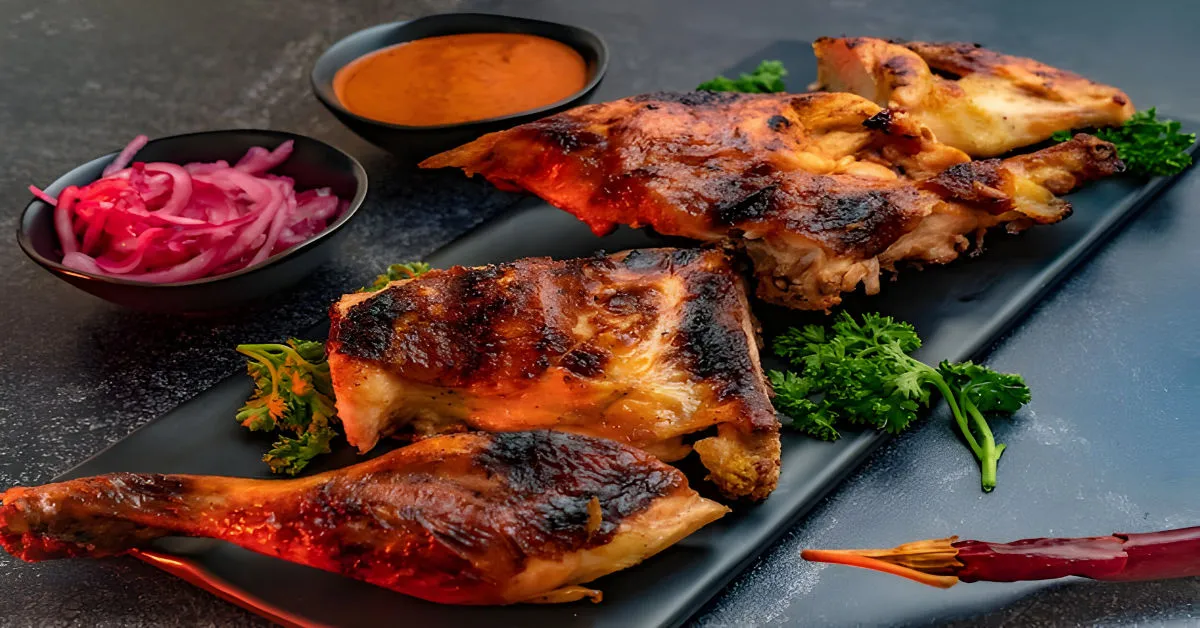Diving into the heart of Hawaiian cuisine, we uncover the smoky, savory delight known as pulehu chicken. This dish, a testament to the islands’ rich culinary tradition, marries simple ingredients with a cooking technique that’s as ancient as it is flavorful. In this article, we’ll embark on a culinary journey, exploring everything from the basics of pulehu chicken to the nuances that make it a standout in Hawaiian cookouts. So, whether you’re a seasoned chef or a curious foodie, get ready to add a dash of tropical flair to your cooking repertoire.
Introduction to Pulehu Chicken
What is Pulehu Chicken?
At its core, pulehu chicken is a classic Hawaiian dish that’s all about simplicity and flavor. The term “pulehu” translates to “cooked over hot coals,” a method that imparts a distinctive smoky taste to the chicken. This dish is not just food; it’s a celebration of Hawaiian culture, a nod to the islands’ love for gatherings around the grill.
Brief History and Cultural Significance
The roots of pulehu cooking stretch back through Hawaii’s history, intertwining with the traditions of Polynesian navigators who first settled the islands. These early Hawaiians were masters of using what the land and sea provided, and pulehu cooking was a natural, flavorful way to prepare their meals. Over time, pulehu chicken has evolved, absorbing influences from Asia and beyond, yet it remains a beloved staple, a symbol of Hawaiian hospitality and the joy of sharing a meal with ohana (family).
In this part of our culinary exploration, we’ve only just scratched the surface. As we delve deeper into the specifics of making pulehu chicken, including the ingredients and preparation steps, you’ll discover how this dish can bring a taste of Hawaii to your table, no matter where you are. So, let’s get ready to marinate, grill, and savor the rich, tangy flavors of this island favorite.
The Recipe pulehu chicken
Ingredients
When it comes to whipping up a batch of pulehu chicken, the ingredient list is surprisingly straightforward, yet each component plays a pivotal role in creating the dish’s signature flavor. You’ll need:
- Chicken thighs: Opt for skinless and boneless, trimmed of excess fat. Thighs are the star of the show, known for their juiciness and ability to stay tender on the grill.
- Soyu or soy sauce: This provides the salty, umami base of the marinade. For a gluten-free option, coconut aminos are a fantastic substitute.
- Garlic powder and dry ginger: These spices add depth and a hint of warmth to the marinade.
- Sesame oil: A touch of this oil brings a nutty, rich flavor to the mix.
- Lemon juice: Freshly squeezed lemon juice brightens the marinade, adding a zesty kick.
- Salt and black pepper: Essential for seasoning and bringing all the flavors together.
Preparation Steps
Creating the perfect pulehu chicken starts with a good marinade. Here’s how to make it happen:
- Marinade Magic: In a large bowl or zip-lock bag, combine the soyu (or soy sauce), garlic powder, dry ginger, salt, and black pepper. Mix well.
- Add the Chicken: Place your chicken thighs into the marinade, ensuring each piece is well-coated. For the best flavor, let them marinate for at least 2 hours, though overnight is ideal.
- Grill to Perfection: Preheat your grill to a medium-high heat. Grill the chicken thighs for about 5-7 minutes on each side, or until they reach an internal temperature of 165°F. The goal is to achieve a slightly charred exterior while keeping the inside juicy and tender.
pulehu chicken Cooking Techniques
Grilling Techniques
Grilling pulehu chicken is where the magic happens, transforming a simple marinade into a smoky, savory feast. Here’s how to nail it:
- Preheat and Prepare: Ensure your grill is hot and clean. A medium-high heat is perfect for creating those sought-after grill marks without burning.
- Don’t Rush: Place the chicken on the grill, but don’t be tempted to move it around too much. Let it sear undisturbed for a few minutes to develop a crust.
- Flip with Care: Use tongs to flip your chicken only once, ensuring even cooking and those beautiful char lines.
Marinade Secrets
The marinade is crucial for achieving the authentic pulehu flavor. Here are some tips to maximize its impact:
- Time is Flavor: The longer the chicken marinates, the deeper the flavors will penetrate. Overnight is best, but even a few hours can make a difference.
- Balance is Key: Ensure your marinade has the right balance of salty, sweet, and tangy. Adjust according to taste, but remember, the lemon juice and soy sauce are what give this dish its character.
Alternative Cooking Methods
No grill? No problem! You can still enjoy pulehu chicken with these alternatives:
- Broil in the Oven: Set your oven to broil and place the marinated chicken on a broiler pan. Keep an eye on it, flipping once, until it’s cooked through and slightly charred.
- Pan Sear: Heat a cast-iron skillet or pan over medium-high heat. Add a bit of sesame oil and cook the chicken until it’s caramelized and cooked through.
Pulehu Chicken vs. Other Hawaiian Chicken Dishes
Comparison with Teriyaki Chicken
While both pulehu chicken and teriyaki chicken boast a grilled goodness that’s hard to resist, their paths diverge when it comes to flavor profiles and preparation methods. Teriyaki chicken is known for its thick, sweet sauce, made from soy sauce sweetened with sugar, often glazed onto the chicken as it grills. This creates a sticky, glossy finish that’s rich in flavor.
On the flip side, pulehu chicken marries the simplicity of grilling with a marinade that’s less about the sweetness and more about the smoky, savory notes. The soy sauce, sesame oil, and lemon juice blend infuses the chicken with a depth of flavor that’s distinctly Hawaiian, offering a tangy twist that teriyaki doesn’t typically feature.
Pulehu Chicken vs. Huli Huli Chicken
Another popular Hawaiian chicken dish is huli huli chicken, which also enjoys a grilled preparation but with a different flavor palette. Huli huli chicken is basted in a marinade that includes pineapple juice, soy sauce, and brown sugar, giving it a sweeter, more tropical flavor profile compared to pulehu chicken. The term “huli” means “turn” in Hawaiian, referring to the method of continuously turning the chicken as it grills, ensuring each bite is infused with its signature sauce.
While pulehu chicken focuses on a simpler marinade that highlights the smoky flavor of the grill, huli huli chicken is all about that sweet, tangy, and slightly sticky glaze. Both dishes are incredibly delicious and showcase the versatility of Hawaiian grilling techniques, but they cater to different tastes and occasions.
In the realm of Hawaiian cuisine, pulehu chicken stands out for its straightforward yet irresistible charm, proving that sometimes, simplicity is the ultimate sophistication. As we move forward, we’ll delve into the best ways to serve and pair this smoky delight, ensuring your culinary journey is as enriching as it is delicious.
Serving and Pairing
Suggested Side Dishes
The rich, smoky flavor of pulehu chicken pairs wonderfully with a variety of side dishes. Here are some top picks to round out your meal:
- Rice: A simple bed of white rice not only soaks up the delicious marinade but also balances the savory notes of the chicken.
- Salads: For a refreshing contrast, try serving with a Grinder salad. Its crisp texture and vibrant dressing complement the chicken’s smokiness.
- Vegetables: Grilled or roasted vegetables, such as bell peppers, zucchini, and asparagus, add color and nutrition to your plate.
Beverage Pairings
Choosing the right beverage can enhance the flavors of your pulehu chicken. Opt for refreshing, non-alcoholic drinks that cleanse the palate and prepare you for the next delicious bite. Consider:
- Iced Tea: A glass of cold, slightly sweetened iced tea can balance the savory notes of the chicken.
- Lemonade: Homemade lemonade, with its sweet and tart profile, pairs beautifully with the tangy elements of the marinade.
- Coconut Water: For a truly tropical experience, serve chilled coconut water. Its natural sweetness and subtle nuttiness make it a perfect match.
With these serving and pairing suggestions, you’re all set to create a balanced and flavorful meal that showcases the best of Hawaiian cuisine. Whether you’re dining with family or entertaining guests, pulehu chicken served with thoughtful sides and refreshing beverages is sure to be a hit. Next, we’ll dive into the FAQs to address common questions and tips for making this dish a success.
FAQs about pulehu chicken
How long can you marinate pulehu chicken?
The sweet spot for marinating pulehu chicken is anywhere from 2 hours to overnight. Marinating for at least 2 hours ensures the flavors penetrate the chicken, but letting it sit overnight will deepen those savory, tangy notes even further. Just remember, the longer, the better, but don’t go beyond 24 hours, as the acid in the marinade can start to break down the proteins, affecting the texture.
Can pulehu chicken be made with other proteins?
Absolutely! While chicken thighs are traditional for their flavor and tenderness, pulehu marinade is versatile. Feel free to experiment with chicken breasts for a leaner option, or even venture into other proteins like pork chops or beef tenderloins. The key is in the marinade and grilling technique, which can be applied to a variety of meats.
What is the ideal internal temperature for cooked chicken?
Safety first! The ideal internal temperature for cooked chicken, regardless of the cut, is 165°F (74°C). Using a meat thermometer is the best way to ensure your pulehu chicken is not only delicious but also safe to eat. Insert the thermometer into the thickest part of the meat, avoiding bone, to get an accurate reading.
Can you make pulehu chicken without a grill?
Yes, you can still enjoy the flavors of pulehu chicken without a grill. A hot cast-iron skillet or a broiler in your oven can mimic the high heat and char of grilling. The key is to get the pan or broiler really hot before cooking to achieve that signature caramelization and slight char on the outside of the chicken.
Storage and Leftovers
Storing and Reheating
Pulehu chicken is just as delicious the next day, provided you store and reheat it properly. Here’s how to keep your leftovers tasting great:
- Refrigeration: Store leftover pulehu chicken in an airtight container in the refrigerator for up to 4 days. Make sure it cools down to room temperature before you pack it away to prevent condensation and soggy chicken.
- Freezing: If you’ve made a big batch and want to save some for later, pulehu chicken freezes well. Place the cooled chicken in a freezer-safe bag or container, squeezing out as much air as possible to prevent freezer burn. It can be stored in the freezer for up to 3 months.
- Reheating: To recapture the dish’s original flavor and texture, reheat the chicken in a pan over medium heat or in the oven at 350°F until it’s warmed through. If you’re in a hurry, the microwave will do, but be mindful that it can dry out the meat. Adding a splash of water or chicken broth before reheating can help keep it moist.
By following these storage and reheating tips, you can enjoy pulehu chicken at its best, even days after you’ve made it. Whether you’re savoring leftovers for a quick lunch or repurposing them into a new meal, this dish’s robust flavors and tender texture make it a delightful treat any day of the week.
Ingredients
- 1 lb chicken thighs (skinless and boneless, trimmed of excess fat): Chicken thighs are preferred for their juiciness and ability to stay tender when grilled.
- 1 tablespoon soyu or soy sauce: This provides the salty, umami foundation of the marinade. You can also use coconut aminos as a gluten-free alternative.
- 2 teaspoons garlic powder: Adds a pungent, savory flavor that complements the chicken beautifully.
- ½ teaspoon dry ginger: Offers a tangy and slightly spicy note, pairing well with the umami-rich soyu.
- ½ teaspoon salt: Essential for seasoning and enhancing all the other flavors in the dish.
- 1 tablespoon sesame oil: Brings a mildly nutty and sweet flavor to the marinade. Can be substituted with other neutral-tasting high-heat oils if necessary.
- 1 tablespoon lemon juice: Freshly squeezed lemon juice brightens the marinade with a fresh citrus flavor, helping to balance the richness of the sesame oil and soyu.
- Ground black pepper to taste: Adds a slight bite and complexity to the sweet and savory chicken.
And there you have it—a complete guide to making, serving, and savoring pulehu chicken, a Hawaiian classic that’s sure to bring a taste of the islands to your table. From its simple yet flavorful marinade to the smoky char of the grill, this dish is a celebration of Hawaiian culinary traditions and a testament to the joy of shared meals. So, fire up the grill (or your preferred cooking method) and get ready to enjoy a delicious, tropical feast that’s bound to become a favorite.


